Hats and Bits PV

Beez Neez now Chy Whella
Big Bear and Pepe Millard
Tue 6 Oct 2015 22:57
|
Bangles,
Bracelets, Mask, Ceremonial Hats and Other Bits and Bobs, Cultural Museum, Port
Vila
  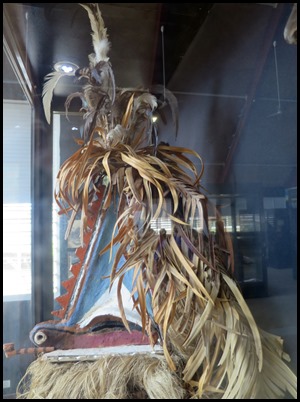 Wooden Mask – Chubwan or Chubaan, made by Sa’a language speakers, South
Pentecost. Traditionally used in ritual Tebatna Lobung in the Bunlap area. This
ceremony followed the men’s sacred meal for the first yams harvested in April.
Knowledge necessary for carving such masks was exclusive property. For a
ceremony, four Chubwan masks, two black and two whitened by ash, and a special
one called Tebat Na Lobung were made. On the day of a ceremony, the principal
dancer proceeded to the dancing ground accompanied by the sound of bamboo
flutes, conch shell trumpets and loud cries. While the masked men danced, others
hurled stones and women threw clumps of earth at the figures to attract their
attention, but it was never intended that the sacred figures be hit. The
ceremony ended with a meal of yam laplap. This rite is no longer practised in
Bunlap.
 Pigs are like money and still play an
important role in Ni-Vanuatu culture. They’re used in traditional ceremonies, in
trade negotiations and marriages. They are presented to the wife’s family after
the birth of the first boy. They are used as a gesture of peace with the tusk
from a pig’s head being used as a symbol of remembrance. Pigs tusks are also
made into armbands and bracelets, which can be found in jewellery stores in the
town, popular with tourists. Pig killing is part of the custom of the land – it
certainly isn’t for the pig as the dispatch of the animal is rarely immediate.
Tusks are represented symbolically – on the flag, currency, also the logo of Air
Vanuatu and on Tusker beer labels. This beautiful pig’s
tusk was presented to Queen Elizabeth who in turn donated back to the
museum for the people of Vanuatu.
 Red Mat.
In Pentecost and Ambae, red mats are used as currency. They are made of pandanus
leaf and only women are allowed to produce them. Traditional money is used to
buy almost all the necessities of ritual and spiritual life. Red mats, for
example, are used for the payments and exchanges involved in marriage,
initiation and graded rituals. During the marriage, the bride will exchange her
red mats for the bridegroom’s tusker pigs. The red colour is said to symbolise
menstrual blood.
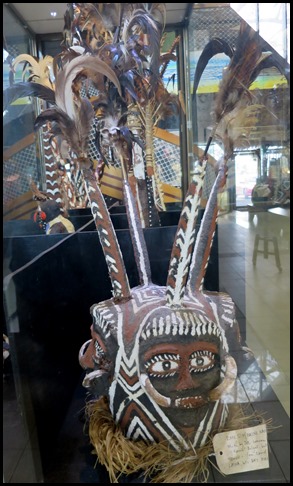  Headdresses. All of these headdresses are from south west
Malekula. [Nalwan or Nalawan is a kind of ceremony that any man or woman can
perform if he or she pays for the right. All the headdresses in the museum have
been used in ceremonies such as, circumcision, funeral, grade taking, yam or
many others. Only the person who pays for the right to use it can wear it and
dance with it.]
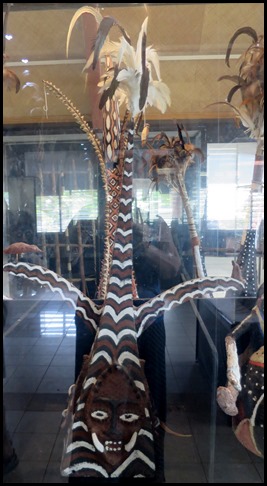   Wohobon.
Lawa Village. This headdress is used in any Nalawan ceremony.
Nivinbur.
Toman Island. Used during circumcision ceremonies.
Netemes
Ninu. Malfakhal village. Used during Nalawan Vimbump.
  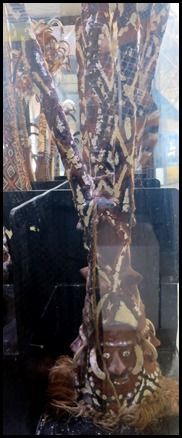 Nalawan
Nohsua. Lawa village. Used during the yam festival.
Ninbur.
Toman Island. Used during a circumcision ceremony.
Swumbo
Mahahu. Lawa village. Used during Nalawan Nemesiene - a funeral
ceremony.
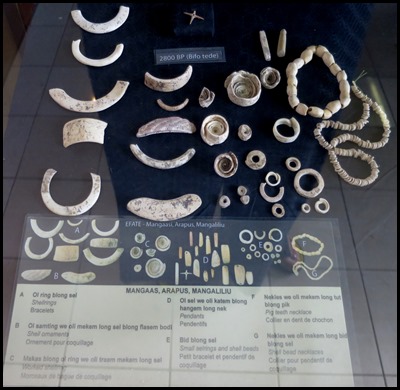  Bracelets.
 Tooth Extraction. This procedure, where the two top middle incisors were extracted,
was performed solely on girls and it marked their marriage status. It was
undertaken only after a girl had got her second set of teeth, after the age of
seven or eight and when the full bride price had been paid – a betrothal or
engagement The practise was also thought to ensure growth and strength. It was
restricted to areas such as east Santo, the west coast of Malekula and possibly
on Epi. The teeth were generally loosened or knocked out by hitting a stick that
was held directly against the tooth.
Hair Dos. These were not particularly
distinctive throughout much of Vanuatu apart from the south. On Aniwa, Futuna,
Tanna and Aneityum elaborate plaiting of the hair was a common feature for boys
and men. Once boys had reached puberty and their hair was some fifteen
centimetres long, it was bleached with lime and divided into approximately seven
hundred individual strands. Around each of these strands was wound a spiral of
fine thread which was regularly added to as the hair grew. When the strands were
long enough they were tied together in a bundle behind the
head.
Nose Piercing. Piercing the cartilage
of the nose and associated insertion of an ornament was a widespread practise
throughout Vanuatu included those made of wooden sticks or stones, wooden plugs
and sea urchin spines. The custom of deforming the
nose was present but less common. A hole was made in the septum and a springy
coil, normally made from a strip of thin elastic bark or pandanus rolled up like
a watch spring, was inserted vertically. The steady pressure of the spring
enlarged the nose – the larger the nose, the more elegant the individual was
conceived to be. Ear piercing and body
painting have also been recorded.
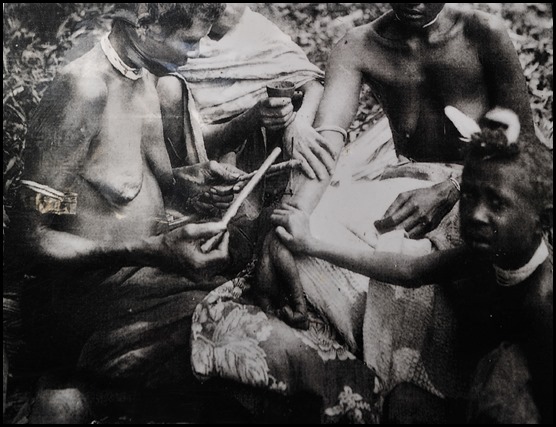 Women tattooing a
girl in Aoba. 1920 – F. Speiser.
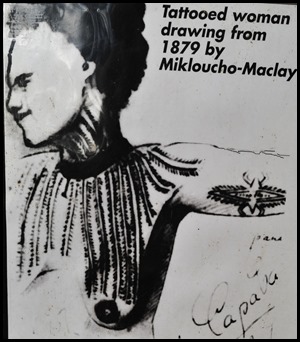   Tattooing used to be prevalent
throughout Vanuatu. In 1920 F. Speiser noted “almost every individual has
somewhere on his body a few black dots or lines. Tattooing was more common in
islands where the population were lighter skinned such as the Banks Islands,
Aoba [Ambae], Efate and Erromango.
In Aoba tattooing was obligatory
decoration for both sexes. Depending on their rank in society, men could pay in
pigs for the rights to special designs. Girls were not tattooed until they were
betrothed and according to the rank held by their father, women received more
and more tattoos the higher their father rose in rank, in some the whole body
was covered. Tattooing was done by women. A needle consisting of two orange
thorns tied to a stick was used. First the design was drawn on the skin with a
fine point dipped in tattooing colour, then the woman seized the needle in her
hand and tapped it with a stick after being dipped in the pigment paste made by
heating a piece of nangae nut tree in a fire until sap dripped out, this was
collected in a coconut shell. The same juice was rubbed over the new tattoo to
stop it festering. A great deal of pigment oozed from the wound and the scab
formed after ten days or so. When healed the tattoo was lighter than at the
start and was reported as “not being too painful.” Payment to the lady artist
was in pigs. The missionaries did the best they could to rid the land of the art
form, many would say successfully but were they................
 Scarification has also been recorded.
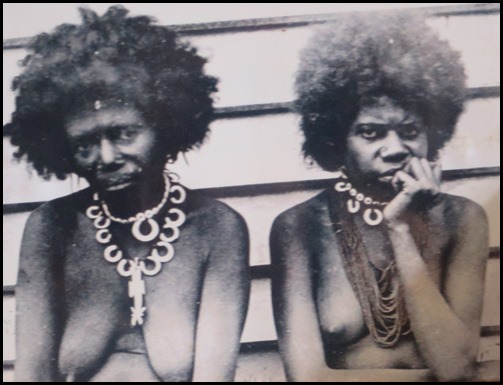 Two Futunese
women with necklaces and rings made from small conus shell rings.
1890’s.
 Women wearing ear
ornaments and a variety of necklaces, including Chinese beads, Tanna.
1913.
  Chief
Ilabnambenpen from Malekula wearing shell and wooden bracelets, a shell
bead band, a necklace of pig tusks, a band around his head and a twig or bone
pierced through his nose. An
Ambae chief wearing a headdress, armband and belt made form small conus
shell beads woven together.
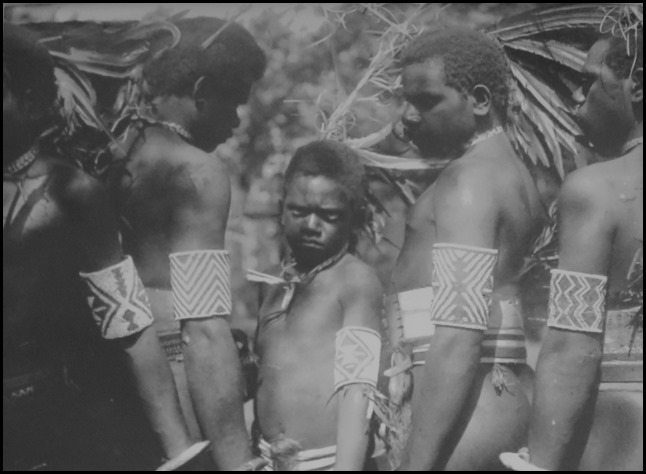 Small
Nambas seen emerging from their circumcision ceremony, wearing trochus
bracelets, shell bead armbands and adorned hair with leaves and
feathers.
 Chief Jerry Taki with some
dancers from Erromango wearing tapa.
 .
.ALL IN ALL A COMPLEX SOCIETY IN A SIMPLE LIFE
PRETTY SPECTACULAR
|